Zoom
Trash

Limor Fried’s Artful Electronics. In 1880, Giovanni Morelli, a sixty-four-year-old critic and historian from Italy, caused a sensation in the art world.
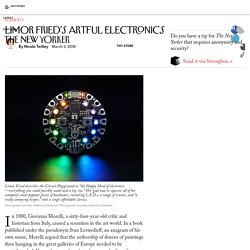
In a book published under the pseudonym Ivan Lermolieff, an anagram of his own name, Morelli argued that the authorship of dozens of paintings then hanging in the great galleries of Europe needed to be reattributed. A Venus that was thought to be a copy by Sassoferrato of a lost Titian was actually one of just a handful of surviving paintings by the elusive Giorgione; a sketch of a young man’s head and hand, ascribed to Raphael, must instead be credited to a nameless “Northern master.” Morelli’s book launched the Morellian system of connoisseurship, with which the work of each of the Italian Renaissance painters could be identified by means of the characteristic ways in which they depicted small, seemingly insignificant details—earlobes, leaves, and the like.
How the BBC micro:bit will kick-start a coding revolution. This article was first published in the October 2015 issue of WIRED magazine.
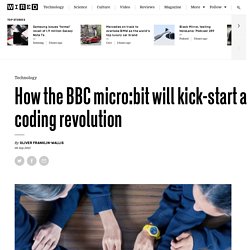
Be the first to read WIRED's articles in print before they're posted online, and get your hands on loads of additional content by subscribing online. It's 9.30 on a cloudy morning in June, and in an IT classroom overlooking the playground at Winterton Community Academy in Scunthorpe, a group of Year 7s is learning how to code. Twenty-four excitable students sit around the school's RM One PCs playing Flash games online before the teacher, Mark Sidell, sets them to work in Blockly, a visual programming language.
The kids begin piecing together bricks of code like Lego ("if x, do y"; "repeat") and testing it using an on-screen simulator. Since changes to the curriculum in September 2014 - when coding and computer science were brought in to replace the failing ICT curriculum -- this has been a common sight in UK classrooms. Winterton possesses some of the first micro:bits in existence. Coding in the 80s. Magnus Carlenäs - Jag kommer påbörja ett arbete med att få... Arduino grunder (OneTab-länkar) Att programmera en Arduino v.12. Här jobbar vi med Arduino – Carl Bärstad. Arduino - blockprogrammering på Chromebook. Idag fick jag ett spännande mail angående Arduino - blockprogrammering - Chromebook.
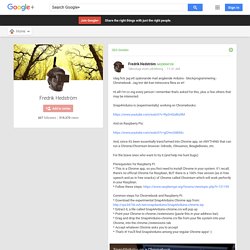
Jag tror det kan intressera flera av er! Hi all! I'm cc-ing every person I remember that's asked for this, plus a few others that may be interested. Snap4Arduino is (experimentally) working on Chromebooks: And on Raspberry Pis: And, since it's been essentially transformed into Chrome app, on ANYTHING that can run a Chrome/Chromium browser. For the brave ones who want to try it (and help me hunt bugs): Prerequisites for Raspberry Pi:* This is a Chrome app, so you first need to install Chrome in your system.
Common steps for Chromebook and Raspberry Pi:* Download the experimental Snap4Arduino Chrome app from: Extract it, a file called Snap4Arduino-chrome.crx will pop up* Point your Chrome to (paste this in your address bar).* Drag and drop the Snap4Arduino-chrome.crx file from your file system into your Chrome, into the tab* Accept whatever Chrome asks you to accept* That's it! Arduino Vs. Raspberry Pi: Which Is The Right DIY Platform For You? If you’re at all familiar with do-it-yourself (DIY) electronics, you’ve probably heard about the comparable merits of Arduino and Raspberry Pi.
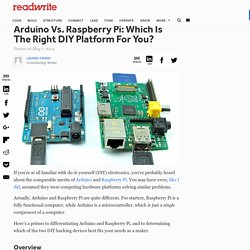
You may have even, like I did, assumed they were competing hardware platforms solving similar problems. Actually, Arduino and Raspberry Pi are quite different. For starters, Raspberry Pi is a fully functional computer, while Arduino is a microcontroller, which is just a single component of a computer. Here’s a primer to differentiating Arduino and Raspberry Pi, and to determining which of the two DIY hacking devices best fits your needs as a maker.
Overview Raspberry Pi and Arduino were both originally designed to be teaching tools, which is why they’ve become so popular—both devices are very easy to learn to use. See also: 12 Cool Projects For Your Raspberry Pi Raspberry Pi hails from the United Kingdom. Arduino, on the other hand, was born in Italy. Arduino unleashes a serious Internet of Things system for hardware hackers. MaKey MaKey - An Invention Kit for Everyone. This Is the Easiest Way to Build Accessibility Tech for Kids with Disabilities. MaKey MaKey, the alligator clip-able USB drive that controls computer input, has become somewhat synonymous with bizarre circuit building projects like turning a troupe of bananas into a working piano.
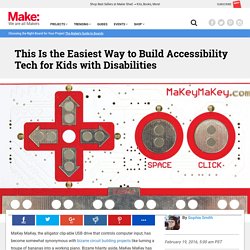
Bizarre hilarity aside, MaKey MaKey has also become an incredibly useful accessibility tool for those with physical and cognitive disabilities. Maker Tom Heck had been working in education for most of his adult life, but he initially felt unsure how to help a classroom of students with special needs. In the TED talk below, Heck gives a short overview of the current state of accessibility devices available to students with disabilities.
In short they’re expensive, one-size-fits-all, and prone to breaking, all of which boils down to frustrated classrooms that have difficulty obtaining working replacements. Heck decided to put the versatility of MaKey MaKey to use. Since his TED talk on the project last year, Heck has become the VP of Education Initiatives for MaKey MaKey. BBC Microbit at Maker Faire Bay Area 2016. Touch Board. Buy Capacitive touch, distance sensing, MP3, MIDI & more on the Arduino-compatible Touch Board The Touch Board is a powerful prototyping tool which combines Arduino compatibility with robust capacitive touch, distance sensing, an MP3 Player, MIDI functionality and a LiPo battery charger.
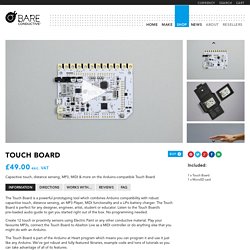
The Touch Board is perfect for any designer, engineer, artist, student or educator. Listen to the Touch Board’s pre-loaded audio guide to get you started right out of the box. No programming needed. Create 12 touch or proximity sensors using Electric Paint or any other conductive material. The Touch Board is part of the Arduino at Heart program which means you can program it and use it just like any Arduino. Not sure where to get started? Getting started is easy The Touch Board comes pre-programmed with an audio guide that takes you through basic features and highlights of the board. Getting Started with the Touch Board Capacitive touch and distance sensing.
Raspberry Pi - Enkortsdator. Arduino Comes To The Raspberry Pi, Linux ARM Devices. Vinnova planerar miljonregn över Raspberry Pi-pysslare. Raspberry Pi.
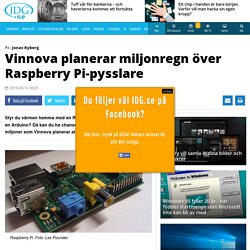
Foto: Les Pounder. Statliga innovationsmyndigheten Vinnova hoppas få en kreativ injektion från den så kallade maker-rörelsen. Till sommaren planerar myndigheten en utlysning på totalt fem miljoner kronor som kan sökas av föreningar och organisationer inom den så kallade makerrörelsen. Kano på Maker Faire Bay Area 2016. Svart låda.